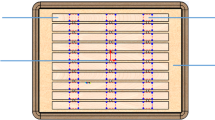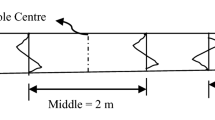Subject
Some physical and mechanical properties together with the natural decay resistance of the lesser known and lesser utilized timbers of Diospyros mespiliformis, Tyrachylobium verrucosum and Newtonia paucijuga, species from Tanzania were determined. The physical and strength properties of the timber species were determined following the methods of BS 373 (1957), Lavers (1969) and Ishengoma and Nagoda (1991). Natural decay resistance was determined using the brown-rot fungi (Coniophora puteana and Goeophyllum trabeum) and the white rot fungus (Coriolus versicolor) for both heartwood and sapwood in accordance with EN 113 (1993).
Results show that, D. mespiliformis and T. verrucosum are high density timbers with basic densities of 719 and 745 kg/m3, respectively, while N. paucijuga is a medium density timber with a basic density of density 607 kg/m3. With the exception of radial cleavage strength, which were comparable for all the timbers tested, T.verrucosum had higher strength properties than D. mespiliformis. Newtonia. paucijuga showed lowest strength value specifically in modulus of rupture (MOR), modulus of elasticity (MOE) and compressive strength than the other timbers tested. The work to maximum load, shear and radial cleavage strength of D. mespiliformis and N. paucijuga were comparable. If these timber species are promoted, D. mespiliformis and T. verrucosum can substitute Cassiporea malosana and Newtonia paucijuga can substitute Populus canescens.
Natural durability ratings according to EN 350-1 (1993) were as follows; N. paucijuga—1 (durable), D. mespiliformis—5 (not durable) and T. verrucosum—5 (not durable).

Similar content being viewed by others
References
Amartey SA, Faakye C, Gillah PR (2001) Natural decay resistance of some lesser-utilised Ghanaian timbers to wood decay fungi. In: Proceedings of the fifth international conference on the development of wood science, wood technology and forestry, Ljubljana, Slovenia, 5th–7th September, pp 35–43
ASTM D2017 (1994) Accelerated Laboratory test of natural decay resistance of woods. American Standard Testing Methods
BS 373 (1957) Methods for testing small clear specimens
Desch HE (1981) Timber its structure and properties. Macmillan Press, London
Eaton RA, Hale MDC (1993) Wood decay, pests and protection, 1st edn. Chapman and Hall, London
EN 113 (1993) Wood preservatives determination of toxis values against wood destroying Basidiomycetes cultured on agar medium. European Committee for Standardization, Brussels
EN 350-1 (1994) Durability of wood and wood based products—Natural durability of solid wood part 1: Guide to the principle of testing and classification of the Natural durability of wood. European Committee for standardization, Brussels
Ishengoma RC, Nagoda L (1991) Solid wood physical and mechanical properties defects grading and utilization as fuel. In: A teaching compendium for forest students. Faculty of Forestry and Nature Conservation, Sokoine University of Agriculture, Morogoro, Tanzania
Ishengoma RC, Gillah PR, Chihongo AW (1997) Properties of lesser utilized Trichilia emetica (rocka) and Pterocarpus stolzii timber species of Tanzania. Ann Forest 5(1):10–15
ISO 3130 (1975) Wood determination of moisture content for physical and mechanical tests, 1st edn. (UDC 674.03:543.812) International organization for Standardization, Switzerland
ISO 3131 (1975) Wood determination of density for physical and mechanical tests, 1st edn. (UDC 674.03:531.754) International organization for standardization, Switzerland
Lavers GM (1969) The strength properties of timbers. Forests Research Bulletin No. 50 (2nd edn., Metric Units). Forest Products Research Laboratory, Princes Risborough, Her Majesty’s Stationary Office, London
Lockyer R (1994) Forest residue utilization and plantation harvesting. Asian Timber J 13:22–15
Pohleven F, Petric M (1997) Resistance of the wood of Eucalyptus saligna and Paulownia Tomentosa against some wood rotting fungi. International Research Group on Wood Preservation, Document No. IRG/WP97-10238
Zabel R, Morrel JJ (1982) Wood microbiology: decay and its prevention between different accelerated test methods for the determination of the natural durability of wood. International Research Group on Wood Preservation, Document No. IRG/WP 96-20099
Author information
Authors and Affiliations
Corresponding author
Rights and permissions
About this article
Cite this article
Ishengoma, R.C., Gillah, P.R., Amartey, S.A. et al. Physical, mechanical and natural decay resistance properties of lesser known and lesser utilized Diospyros mespiliformis, Tyrachylobium verrucosum and Newtonia paucijuga timber species from Tanzania. Holz Roh Werkst 62, 387–389 (2004). https://doi.org/10.1007/s00107-003-0452-z
Published:
Issue Date:
DOI: https://doi.org/10.1007/s00107-003-0452-z




